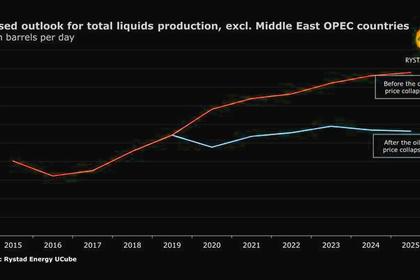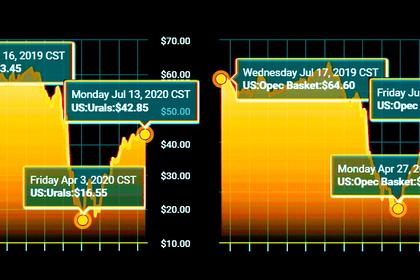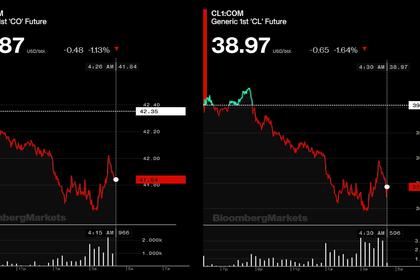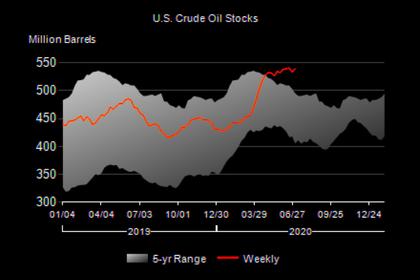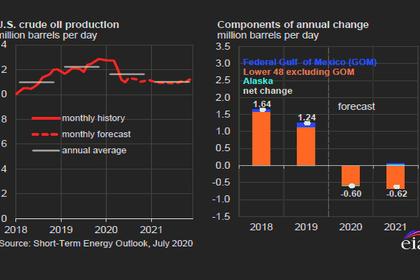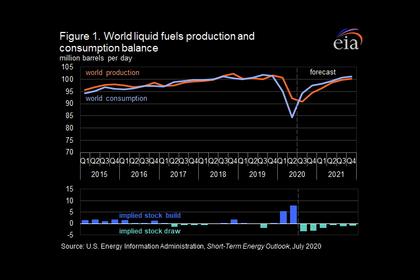
OIL DEMAND WILL UP
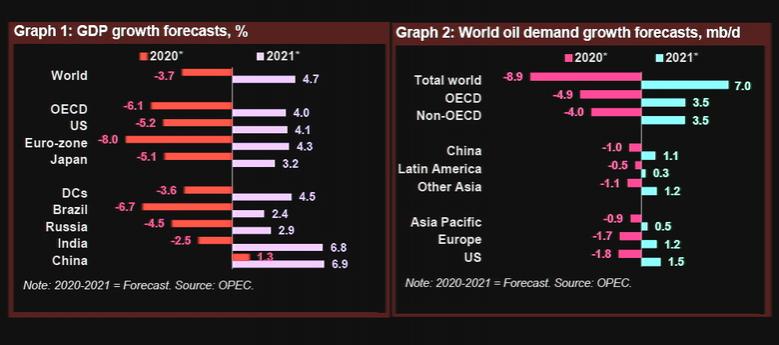
OPEC - 14 July 2020 - OPEC MONTHLY OIL MARKET REPORT
Oil Market Highlights
Crude Oil Price Movements
Spot crude oil prices continued rising in June for the second consecutive month, given the continued improvement in physical crude market fundamentals and gradual reductions in global supply overhang. The OPEC Reference Basket (ORB) value rose by $11.88, m-o-m, to $37.05/b, up by 47.2%. In June, ICE Brent rose by $8.36, or 25.8%, to average $40.77/b, while NYMEX WTI rose by $9.79, or 34.3%, to average $38.31/b. The increase was driven by a drop in global oil surplus, signs of further improvements in oil market fundamentals, as well as prospects that the oil market would tighten further in 2H20. The contango structure of Brent and WTI continued to ease, while the DME Oman structure flipped into mild backwardation. Hedge funds and other money managers slightly raised their bullish bets on futures and options contracts in June, amid concerns about the spike of COVID-19 cases worldwide and potential impact on economic activity and oil demand.
World Economy
World economic growth in 2020 is revised down to -3.7%, compared to -3.4% in the previous month, following a more pronounced impact of COVID-19 on a few emerging and developing economies. The major contraction in 2020 is forecast to be followed by a recovery in 2021, with global economic growth forecast at 4.7%. The US is projected to contract by 5.2% in 2020, followed by growth of 4.1% in 2021. The Euro-zone is forecast to contract by 8.0% in 2020, and grow by 4.3% in 2021. Japan is expected to decline by 5.1% in 2020 and recover by 3.2% in 2021. China’s 2020 GDP is forecast to still grow by 1.3%, followed by growth of 6.9% in 2021.
India’s 2020 growth is forecast to decline by 2.5%, followed by growth of 6.8% in 2021. Brazil’s 2020 GDP is forecast to drop by 6.7%, but rebound to growth of 2.4% in 2021. Russia’s economy is forecast to contract by 4.5% in 2020, and recover in 2021, growing by 2.9%.
World Oil Demand
Global oil demand growth in 2020 is revised up by 0.1 mb/d from the previous month’s assessment, to show a decline of around 8.9 mb/d. Better-than-expected data in the OECD region in 2Q20 slightly eased the historically steep drop, and more than offset the downward adjustment, in non-OECD oil demand, mainly in Other Asia. In 2021, oil demand is forecast to partially recover from the current year to show historic high growth of 7.0 mb/d. Regionally, both the OECD and the non-OECD regions are forecast to grow by 3.5 mb/d, y-o-y. In terms of products, gasoline and diesel are anticipated to record the highest y-o-y gains, although, ongoing efficiency gains, including tele-working and tele-conferencing, may cap oil demand gains in 2021 to remain below pre-crisis levels of 2019.
World Oil Supply
Non-OPEC liquids production growth in 2020 (including processing gains) is revised down by a minor 30 tb/d from the previous assessment, and is expected to decline by 3.26 mb/d, y-o-y. In addition to the downward adjustments of the ten non-OPEC countries participating in the Declaration of Cooperation (DoC) by 1.89 mb/d in 2Q20, production shut-ins due to the Covid-19 pandemic, low oil prices and storage or offtake issues in countries outside of the DoC, are estimated to average 3.55 mb/d during the same quarter. US production growth is revised up by 68 tb/d, due higher-than-initially expected production in 2H20, now showing a decline of 1.37 mb/d in 2020, y-o-y. For 2021, non-OPEC liquids production is forecast to grow by 0.92 mb/d. The US, Brazil, Norway, Canada, and Australia are forecast to be the main drivers for growth in 2021. OPEC NGLs are estimated to decline by 0.10 mb/d, y-o-y in 2020, while the preliminary 2021 forecast indicates growth of 0.08 mb/d to average 5.13 mb/d. OPEC crude oil production in June decreased further by 1.89 mb/d m-o-m to average 22.27 mb/d, in compliance with the Conference decisions and above 100% conformity, according to secondary sources.
Product Markets and Refining Operations
In June, refinery margins in the Atlantic Basin came under pressure, affected by stronger crude prices and growing concerns over a second wave of the COVID-19 pandemic, which offset earlier gains in refining economics towards the end of the month. This downturn was particularly pronounced in Europe, while in the USGC, margins managed to improve slightly owing to stronger diesel exports. In Asia, margins rebounded and showed large gains in complex configurations as gasoline cracks jumped in line with positive consumption indicators, particularly in South Korea and India, amid hefty refinery intake cuts and stronger fuel import requirements from Japan.
Tanker Market
Dirty tanker rates broadly trended lower across most routes in June, receding from higher levels seen earlier in the year. The decline in rates was driven by production adjustments to address the oversupply in the market, increased tonnage availability amid the gradual unwinding of floating storage, and lower import needs globally as product demand remained weak. Similar factors kept clean spot freight rates muted in June.
Crude and Refined Products Trade
Preliminary data for June shows US crude imports continued to recover, reaching 6.5 mb/d, up from the low of 5.5 mb/d seen in April. Product imports also improved, led by a recovery in gasoline. US crude exports declined to average 2.8 mb/d; meanwhile, product exports improved, led by diesel. China's crude imports surged to a record 11.3 mb/d in May, as a wave of crude cargoes purchased at a time of low prices began to arrive in Chinese waters. Product imports also saw record highs of 1.8 mb/d, with LPG and naphtha both showing gains. China's product exports fell by more than half to just under 1 mb/d, for the first time since April 2017. India's crude inflows approached a 6-year low of 3.4 mb/d in May, amid reduced refinery runs and swelling commercial inventories.
Commercial Stock Movements
Preliminary May data showed that total OECD commercial oil stocks rose by 29.9 mb, m-o-m, to stand at 3,167 mb. This was 232 mb higher than the same time one year ago, and 210 mb above the latest five-year average. Within the components, crude and product stocks rose by 9.7 mb and 20.2 mb, m-o-m, respectively.
OECD crude stocks stood at 91 mb above the latest five-year average, while product stocks showed a surplus of 119 mb. In terms of days of forward cover, OECD commercial stocks fell by 5.2 days m-o-m in May to stand at 75.8 days. This was 14.9 days above May 2019, and 13.9 days above the latest five-year average.
Balance of Supply and Demand
Demand for OPEC crude in 2020 was revised up by 0.2 mb/d from the previous month to stand at 23.8 mb/d, which is around 5.6 mb/d lower than in 2019. Based on the preliminary forecast for world oil demand and non-OPEC supply for 2021, demand for OPEC crude for 2021 is forecast at 29.8 mb/d, which will be 6.0 mb/d higher than the 2020 level.
-----
Earlier:

